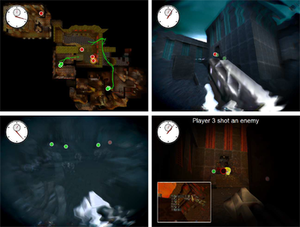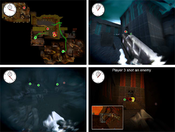Information
- Publication Type: Conference Paper
- Workgroup(s)/Project(s):
- Date: April 2015
- ISBN: 978-80-223-3844-8
- Publisher: Comenius University, Bratislava
- Location: Smolenice, Slovakia
- Lecturer: Peter Mindek
- Editor: Joaquim Jorge, Luis Paulo Santos, Roman Durikovic
- Booktitle: Proceedings of Spring Conference on Computer Graphics 2015
- Conference date: 22. April 2015 – 24. April 2015
- Pages: 93 – 100
- Keywords: storytelling, game visualization, animation
Abstract
We present a novel method for creating automatized gameplay dramatization of multiplayer video games. The dramatization serves as a visual form of guidance through dynamic 3D scenes with multiple foci, typical for such games. Our goal is to convey interesting aspects of the gameplay by animated sequences creating a summary of events which occurred during the game. Our technique is based on processing many cameras, which we refer to as a flock of cameras, and events captured during the gameplay, which we organize into a so-called event graph. Each camera has a lifespan with a certain time interval and its parameters such as position or look-up vector are changing over time. Additionally, during its lifespan each camera is assigned an importance function, which is dependent on the significance of the structures that are being captured by the camera. The images captured by the cameras are composed into a single continuous video using a set of operators based on cinematographic effects. The sequence of operators is selected by traversing the event graph and looking for specific patterns corresponding to the respective operators. In this way, a large number of cameras can be processed to generate an informative visual story presenting the gameplay. Our compositing approach supports insets of camera views to account for several important cameras simultaneously. Additionally, we create seamless transitions between individual selected camera views in order to preserve temporal continuity, which helps the user to follow the virtual story of the gameplay.Additional Files and Images
Weblinks
No further information available.BibTeX
@inproceedings{mindek-2015-mc,
title = "Automatized Summarization of Multiplayer Games",
author = "Peter Mindek and Ladislav \v{C}mol\'{i}k and Ivan Viola and
Eduard Gr\"{o}ller and Stefan Bruckner",
year = "2015",
abstract = "We present a novel method for creating automatized gameplay
dramatization of multiplayer video games. The dramatization
serves as a visual form of guidance through dynamic 3D
scenes with multiple foci, typical for such games. Our goal
is to convey interesting aspects of the gameplay by animated
sequences creating a summary of events which occurred during
the game. Our technique is based on processing many cameras,
which we refer to as a flock of cameras, and events captured
during the gameplay, which we organize into a so-called
event graph. Each camera has a lifespan with a certain time
interval and its parameters such as position or look-up
vector are changing over time. Additionally, during its
lifespan each camera is assigned an importance function,
which is dependent on the significance of the structures
that are being captured by the camera. The images captured
by the cameras are composed into a single continuous video
using a set of operators based on cinematographic effects.
The sequence of operators is selected by traversing the
event graph and looking for specific patterns corresponding
to the respective operators. In this way, a large number of
cameras can be processed to generate an informative visual
story presenting the gameplay. Our compositing approach
supports insets of camera views to account for several
important cameras simultaneously. Additionally, we create
seamless transitions between individual selected camera
views in order to preserve temporal continuity, which helps
the user to follow the virtual story of the gameplay.",
month = apr,
isbn = "978-80-223-3844-8",
publisher = "Comenius University, Bratislava",
location = "Smolenice, Slovakia",
editor = "Joaquim Jorge, Luis Paulo Santos, Roman Durikovic",
booktitle = "Proceedings of Spring Conference on Computer Graphics 2015",
pages = "93--100",
keywords = "storytelling, game visualization, animation",
URL = "https://www.cg.tuwien.ac.at/research/publications/2015/mindek-2015-mc/",
}


 Paper
Paper
